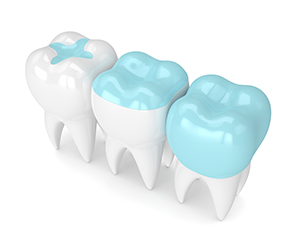Cosmetic Enhancements
Your smile is one of your most important features. Dentistry is continually evolving, and with a variety of advanced treatment options, achieving a beautiful, healthy, aesthetic smile is made easy for patients of all ages.
Are you ready for a smile makeover?
If you're considering cosmetic dental treatment, ask yourself a few simple questions:
- Do you hesitate when you smile?
- Would you like to increase your self-confidence?
- Do you want to look your best in social or professional situations?
- Are you ready to reverse any dental imperfections you may have?
If you've answered yes to any of these questions, cosmetic dentistry may be the answer you've been looking for!
Tooth-Colored Fillings
Modern dental fillings include ceramic and plastic compounds that mimic the appearance of natural teeth. These compounds, often called composite resins, are usually used on the front teeth where a natural appearance is important, as well as on the back teeth depending on the location and extent of the tooth decay.
What's right for me?
Several factors influence the performance, durability, longevity, and expense of dental restorations, including:
- The components used in the filling material
- The amount of tooth structure remaining
- Where and how the filling is placed
- The chewing load that the tooth will have to bear
- The length and number of visits needed to prepare and adjust the restored tooth.
Before your treatment begins, Dr. Chitgopekar will discuss with you all of your options, and help you choose the best filling for your particular case. To help you prepare for this discussion it may be helpful to understand the two basic types of dental fillings: direct and indirect.
- Direct fillings are fillings placed immediately into a prepared cavity in a single visit. They include glass ionomers, resin ionomers, and composite (resin) fillings. Dr. Chitgopekar prepares the tooth, places the filling, and adjusts it in just one appointment.
- Indirect fillings generally require two or more visits. They include inlays, onlays, veneers, crowns, and bridges fabricated with gold, base metal alloys, ceramics, or composites. During the first visit, Dr. Chitgopekar prepares the tooth and makes an impression of the area to be restored. Dr. Chitgopekar then places a temporary covering over the prepared tooth. The impression is sent to a dental laboratory which creates the dental restoration. At the next appointment, she cements the restoration into the prepared cavity and adjusts it as needed.
Inlays and onlays
Inlays and onlays are a type of indirect restoration, where Dr. Chitgopekar fabricates the restoration outside of your mouth and cements it into place. A direct restoration, most commonly fillings, are placed immediately into a prepared cavity in a single visit.

Inlays and onlays are used in molars or premolars, when the tooth has experienced too much damage to support a basic filling, but not so much damage that a crown is necessary. They can be made of gold, metal alloys, ceramics, or composites. An inlay is used when the cavity rests between the cusps, whereas an onlay covers one or more cusps, as well as the area in between. A crown replaces the entire outside area of the tooth above the gum line.
Indirect fillings generally require two or more visits. During the first visit, Dr. Chitgopekar prepares the tooth and makes an impression of the area to be restored. She then places a temporary covering over the prepared tooth. The impression is sent to a dental laboratory, which creates the dental restoration. At the next appointment, Dr. Chitgopekar cements the restoration into the prepared cavity and adjust it as needed.









